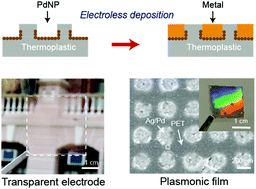Highly-facile template-based selective electroless metallization of micro- and nanopatterns for plastic electronics and plasmonics†
Abstract
The authors reported a facile, scalable, high-yield, universal fabrication approach for creating micro- and nanoscale metallic patterns for flexible electronic and plasmonic applications through imprint-transfer of catalytic Pd nanoparticles using a reusable imprint mold with selectively adsorbed catalytic nanoparticles and selective electroless deposition of metals. Metallic patterns are mass-produced on flexible plastics according to the predefined micro-/nanofeatures on the imprint mold without any chemical modification on the substrate, which significantly reduces both fabrication costs and environmental pollution, compared to other methods utilizing electroless deposition. The excellent dimensional scalability and material versatility of this method have been confirmed by fabricating metallic micromeshes with a linewidth down to 3 μm, and metallic nanodisk arrays with a pitch of 500 nm. Using this method, flexible transparent electrodes were constructed on Cu micromesh-patterned plastic films with transmittance values higher than 75% and sheet resistance values below 0.4 Ohms sq−1, as well as high figures of merit up to 4 × 103. This method is further demonstrated in the fabrication of flexible thin-film heaters, electroluminescent displays, and flexible printed circuits, as well as plasmonic refractometric sensors.



 Please wait while we load your content...
Please wait while we load your content...